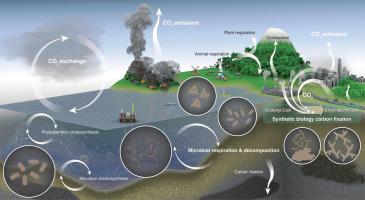Journal of Advanced Research ( IF 11.4 ) Pub Date : 2022-07-30 , DOI: 10.1016/j.jare.2022.07.011 Sulamita Santos Correa 1 , Junia Schultz 2 , Kyle J Lauersen 3 , Alexandre Soares Rosado 4

|
Background
Autotrophic carbon fixation is the primary route through which organic carbon enters the biosphere, and it is a key step in the biogeochemical carbon cycle. The Calvin–Benson–Bassham pathway, which is predominantly found in plants, algae, and some bacteria (mainly cyanobacteria), was previously considered to be the sole carbon-fixation pathway. However, the discovery of a new carbon-fixation pathway in sulfurous green bacteria almost two decades ago encouraged further research on previously overlooked ancient carbon-fixation pathways in taxonomically and phylogenetically distinct microorganisms.
Aim of Review
In this review, we summarize the six known natural carbon-fixation pathways and outline the newly proposed additions to this list. We also discuss the recent achievements in synthetic carbon fixation and the importance of the metabolism of thermophilic microorganisms in this field.
Key Scientific Concepts of Review
Currently, at least six carbon-fixation routes have been confirmed in Bacteria and Archaea. Other possible candidate routes have also been suggested on the basis of emerging “omics” data analyses, expanding our knowledge and stimulating discussions on the importance of these pathways in the way organisms acquire carbon. Notably, the currently known natural fixation routes cannot balance the excessive anthropogenic carbon emissions in a highly unbalanced global carbon cycle. Therefore, significant efforts have also been made to improve the existing carbon-fixation pathways and/or design new efficient in vitro and in vivo synthetic pathways.
中文翻译:

天然碳固定和合成工程的进展,用于重新设计和创造新的固定途径
背景
自养固碳是有机碳进入生物圈的主要途径,是生物地球化学碳循环的关键步骤。Calvin-Benson-Bassham 途径主要存在于植物、藻类和一些细菌(主要是蓝细菌)中,以前被认为是唯一的固碳途径。然而,大约二十年前在含硫绿色细菌中发现了一种新的碳固定途径,这鼓励了对以前在分类学和系统发育上不同的微生物中被忽视的古老碳固定途径的进一步研究。
审查目的
在这篇综述中,我们总结了六种已知的天然固碳途径,并概述了新提议添加到该列表中的途径。我们还讨论了合成碳固定的最新成就以及嗜热微生物代谢在该领域的重要性。
审查的关键科学概念
目前,在细菌和古细菌中至少已确认了六种固碳途径。在新兴的“组学”数据分析的基础上,还提出了其他可能的候选途径,扩展了我们的知识并激发了关于这些途径在生物体获取碳的方式中的重要性的讨论。值得注意的是,目前已知的自然固定途径无法平衡高度不平衡的全球碳循环中过多的人为碳排放。因此,还做出了重大努力来改进现有的碳固定途径和/或设计新的有效的体外和体内合成途径。









































 京公网安备 11010802027423号
京公网安备 11010802027423号